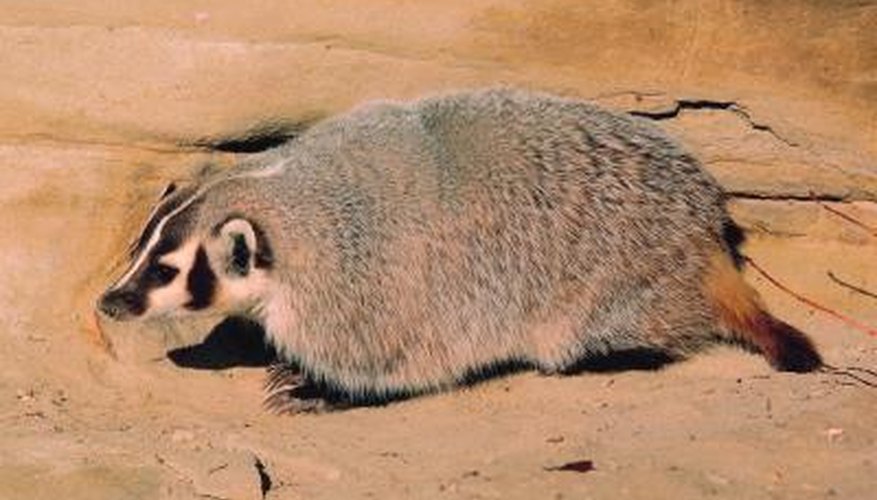The robust, short-legged American badger (Taxidea taxus) measures up to 30 inches in length with a tail that reaches between 4 to 6 inches. Most badgers weigh around 11.8 Kilogram when fully grown but some will weigh up to 18.1 Kilogram. Their fur appears greyish in colour with black highlights and a white stripe on its upturned face and nose. Badgers sport small eyes, small ears and short legs made for digging.
Mating
Females begin to breed when they reach 1 year of age, but males normally do not breed for the first time until they are 2. The badger mates in the late summer to early fall, but implantation of the embryo is delayed until December to February, according to the U.S. Forest Service. During the winter months the badger enters a state of semi-hibernation. The badger burrows into a den during the cold months, but it does emerge during warm winter days to sun itself.
- Females begin to breed when they reach 1 year of age, but males normally do not breed for the first time until they are 2.
- The badger burrows into a den during the cold months, but it does emerge during warm winter days to sun itself.
Birth
From March to April the young are born. The average litter size is three, but can range up to five. The young are born blind and completely dependent upon their mother. The baby badgers' eyes do not open until they reach 4 to 6 weeks old. At 6 weeks, the mother badger begins to wean her babies.
- From March to April the young are born.
- The young are born blind and completely dependent upon their mother.
Summer Months
Once the baby badgers' eyes open, the mother takes her young from the den. The babies will stay with their mother until August and than they will begin life on their own. Often, the mother breaks away from her young as early as June.
Burrows
The badger makes its home in prairies and arid desert areas where they dig burrows. The burrows are often 30-feet long and can reach a depth of 10 feet. The badger usually builds a large bank of soil in front of the entrance to the den for concealment. A badger will excavate more than one den and alternate between each every two or three days.
- The badger makes its home in prairies and arid desert areas where they dig burrows.
- The badger usually builds a large bank of soil in front of the entrance to the den for concealment.
Food Habits
The badger is largely carnivorous, but does indulge in plant life on occasion. Its main diet consists of small rodents, such as prairie dogs, field mice, moles, snakes, lizards, frogs and fish. It also enjoys feeding on insects and relishes bee hives filled with honey.
Hibernation
During the winter months, a badger enters a semistate of hibernation. It will sleep for 29 hours at a time and then awaken. Its heartbeat will slow to half its normal rate and its body temperature will drop, according to the Smithsonian National Museum of Natural History.
Lifespan
Yearly mortality stands at a high 35 per cent, according to the U.S. Forest Service. Highly aggressive in both its temperament and hunting habits, the badger has few enemies. Bears and wolves often pose a threat. Humans are the number one predatory danger to badgers because they are often trapped for their fur or poisoned because they are considered to be nuisances. The badger is also widely hunted, simply for sport. The lifespan of a badger ranges from 9 to 10 years, but it has been known to reach 14 years.
- Yearly mortality stands at a high 35 per cent, according to the U.S. Forest Service.
- The badger is also widely hunted, simply for sport.
